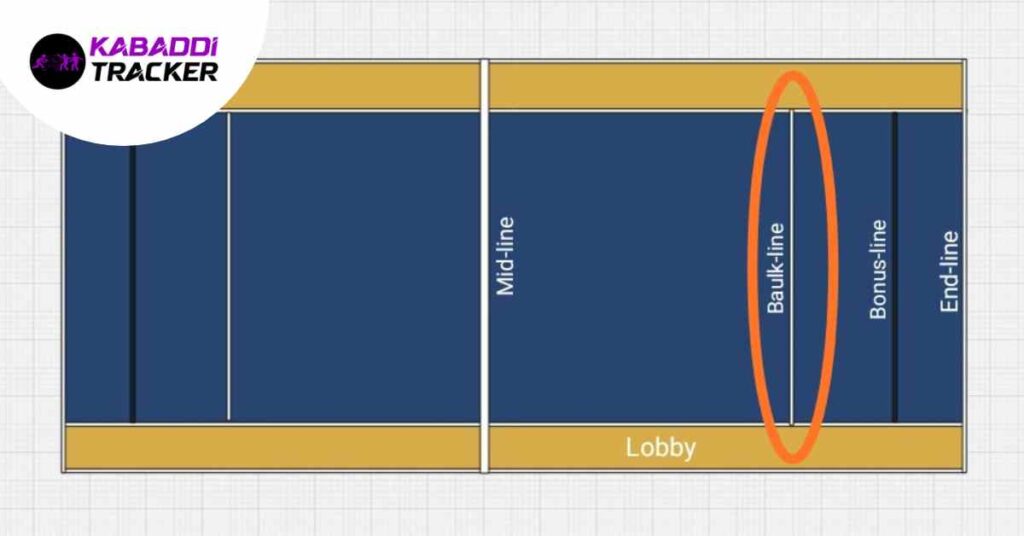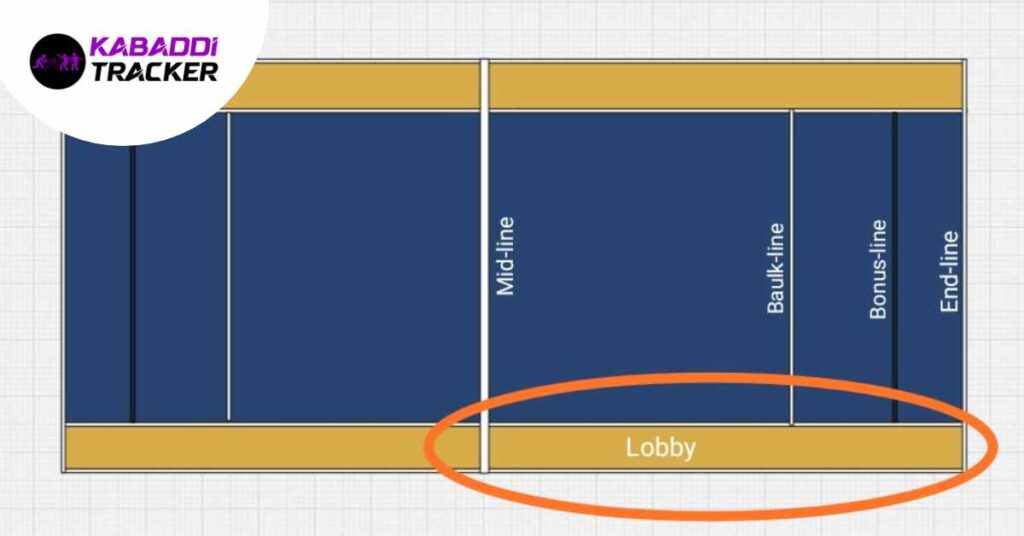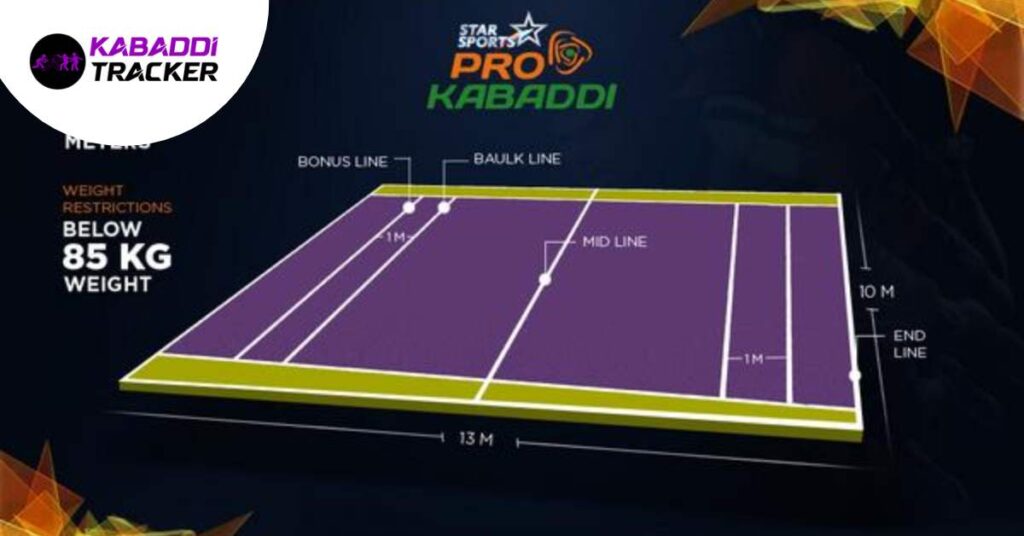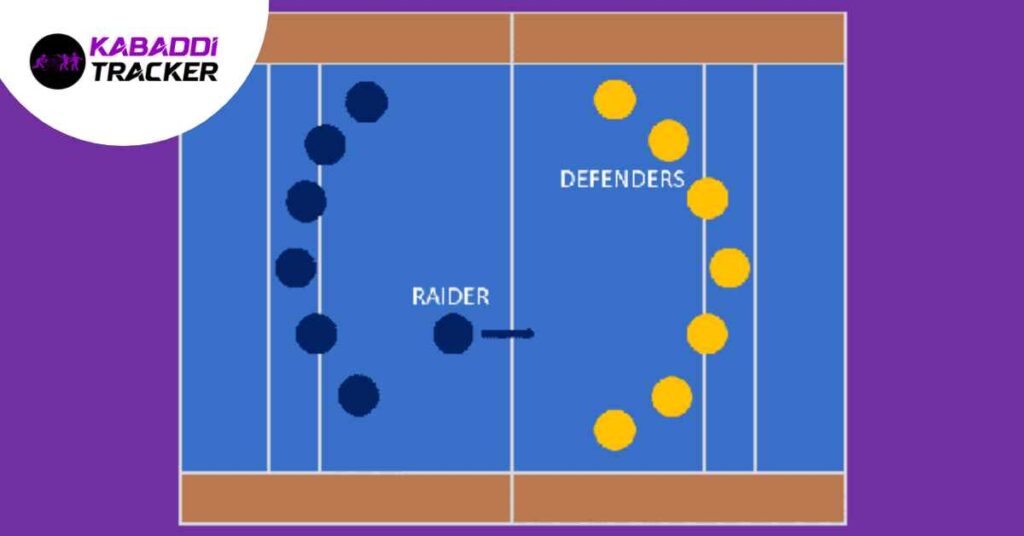Kabaddi, a sport rooted in ancient Indian tradition, has gained international recognition for its unique blend of strategy, skill, and physical prowess. Played on a rectangular court, Kabaddi demands players to exhibit tactical brilliance while adhering to specific dimensions that define the game’s intensity and thrill.
Measuring the Kabaddi court is a critical aspect of the game’s structure, ensuring fairness and competitiveness among players. This article delves into the actual measurements of a Kabaddi court for both men and women, highlighting the nuances that distinguish this exhilarating sport.
The dimensions of a Kabaddi court are standardized to ensure a fair and consistent playing field for both men’s and women’s categories. The court is a rectangular area divided into two halves, each representing the raiding and defending sides.
Here are the typical dimensions of a Kabaddi court:
Kabaddi Court Measurements, Women’s Kabaddi Court Measurement :

Bonus Lines: The placement of bonus lines adds an extra layer of strategy and excitement to the game. Positioned at a distance of 3.75 meters (12.30 feet) from the end lines, these lines serve as significant markers during a raid.
A raiding player who manages to cross the bonus line while tagging opponents not only scores points for their team but also gains the opportunity to earn extra points by returning safely to their side of the court. This element of risk and reward adds to the adrenaline rush of the game, as raiders must balance the pursuit of points with the need to escape the clutches of defenders.

Baulk Line: The baulk line, which is synonymous with the center line, is more than just a demarcation on the court. Placed precisely at the midpoint of the court’s width, the baulk line serves as a psychological and tactical threshold for raiders. It not only separates the two halves of the court but also mandates that raiders initiate their raids from behind this line.
This rule ensures that raiders don’t have a running start, placing them in a position where they must strategize and time their raids with precision. The baulk line thus embodies the strategic essence of Kabaddi, where each raid begins as a test of wit and agility.

Lobbies: Lobbies, situated on both halves of the court, are essentially safe zones that play a crucial role in maintaining the integrity of the game. Extending beyond the end line by a meter on each side, lobbies provide players with a cushion of space that prevents them from stepping out of bounds during the heat of the action.
This addition not only promotes player safety but also contributes to the fast-paced nature of Kabaddi, allowing players to make quick decisions and aggressive moves without the fear of crossing the boundary lines.
Also Read – What are some kabaddi techniques or tips for raiding
Corners: The corners of the Kabaddi court are dynamic areas where strategies unfold rapidly. As the lobbies meet the end lines, corners become hotspots for intense clashes between raiders and defenders.
Defenders often try to pin raiders in these corners, limiting their mobility and making it challenging for them to escape and return safely to their side. On the other hand, skilled raiders can use the corners to their advantage, using quick movements and evasive tactics to secure points.
The corners, with their inherent tactical significance, epitomize the mind games and athleticism that define the sport of Kabaddi.
What is Ground Making of Kabaddi

In the context of Kabaddi, “ground making” refers to the act of a raider crossing the boundary lines of the opposing team’s court during a raid, while simultaneously tagging one or more defenders.
Grounding is a fundamental element of the sport and is crucial for a raider to score points for their team.
When a raider enters the opponent’s half of the court and successfully touches an opposing defender, they score a point for their team. This act is known as a “touch point.”
Additionally, if the raider manages to touch the bonus line during the raid and returns safely to their own half of the court, they earn additional points. These bonus points are typically referred to as “bonus points” or “extra points.”
Also Read – What are the important tournaments of kabaddi
Ground-making is a skill that requires a combination of agility, timing, and strategy. The raider must choose the right moment to initiate the raid, often targeting defenders who are positioned closer to the boundary lines.
Speed and quick decision-making are essential, as defenders will attempt to grab hold of the raider to prevent them from crossing the boundary lines and earning points.
Defenders, on the other hand, strive to prevent the raider from making ground. They employ various techniques, such as forming a chain by holding hands or surrounding the raider to immobilize them. If the defenders manage to restrain the raider within their half of the court without being touched, they earn a point for their team in the form of a “defensive point.”
Ground-making adds a dynamic and strategic dimension to Kabaddi, transforming each raid into a high-stakes encounter between the raider and the defenders. The raider must use their agility to evade the defenders, while the defenders need to work cohesively to anticipate the raider’s moves and thwart their progress.
This interaction between offense and defense, centered around the concept of ground-making, contributes to the intensity and excitement that define the sport of Kabaddi.
Overall, ground-making in Kabaddi showcases the athlete’s ability to navigate physical challenges, employ tactics, and make split-second decisions.
It’s a core aspect of the game that captures the essence of competition and teamwork, making Kabaddi a thrilling and captivating sport to watch and play.
Kabaddi ground diagram with measurement

The kabaddi ground, often referred to as the “kabaddi court,” is a rectangular area divided into two halves by a centerline. The dimensions of the ground may vary slightly based on different levels of play and organizational regulations, but the standard dimensions are as follows:
- Total Area: The kabaddi ground measures 13 meters in width and 10 meters in length, giving it a compact yet dynamic playing surface.
- Midline: The centerline divides the ground into two equal halves. It is parallel to the shorter sides of the rectangle, and it serves as the demarcation between the two teams’ territories.
- Bonus Lines: Approximately 3.75 meters away from the centerline on both sides, bonus lines are drawn parallel to the centerline. These lines are crucial during gameplay, as they define the bonus territory.
- Lobbies: Lobbies, also known as “out lines,” run along the longer sides of the rectangle, creating a boundary for the players. They are typically 1 meter wide.
- End Lines: The shorter sides of the rectangle are termed end lines, and they complete the playing area. These lines serve as the boundaries that players need to cross during raiding and defending.
Key Elements and Their Measurements
- Playing Area: The central area of the kabaddi ground, encompassed by the centerline and bonus lines, is where the majority of the gameplay takes place. Teams raid and defend within this region, aiming to score points by tagging opponents and returning safely to their side.
- Bonus Territory: The area between the centerline and the bonus lines is designated as the bonus territory. Players from the defending team can score extra points if they successfully tag raiders within this region.
- Court Dimensions: The kabaddi ground’s dimensions provide an optimal balance between strategy and intensity. The 13-meter width allows for quick raids and strategic movements, while the 10-meter length ensures that players can’t evade opponents for an extended period.
- Lobbies and End Lines: The lobbies and end lines create a clear boundary for the players, preventing them from stepping out of bounds during the game. These lines also define the limits within which players must operate, adding an extra layer of strategy to the gameplay.





